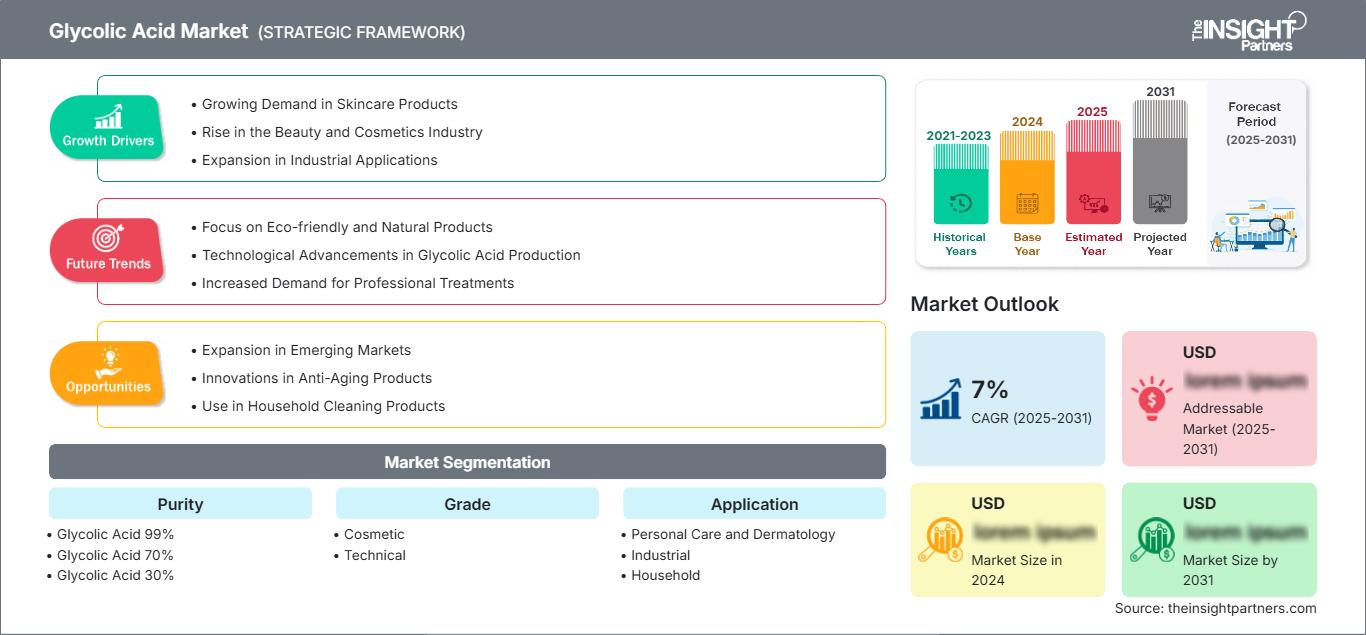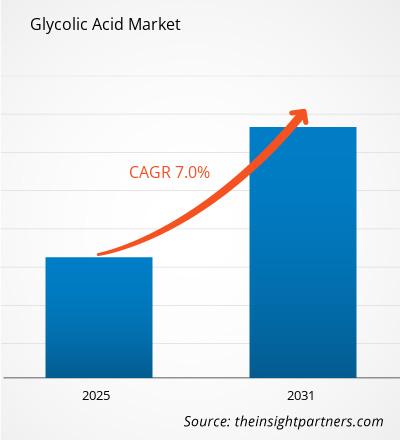Der Glykolsäuremarkt wird voraussichtlich zwischen 2025 und 2031 eine durchschnittliche jährliche Wachstumsrate (CAGR) von 7 % verzeichnen, wobei die Marktgröße von XX Millionen US-Dollar im Jahr 2024 auf XX Millionen US-Dollar im Jahr 2031 anwachsen wird.
Der Bericht ist nach Reinheit segmentiert (Glykolsäure 99 %, Glykolsäure 70 %, Glykolsäure 30 % und Sonstige). Der Bericht präsentiert außerdem eine Analyse basierend auf der Qualität (Kosmetik und Technik). Basierend auf der Anwendung ist der Bericht segmentiert in (Körperpflege und Dermatologie, Industrie, Haushalt und Sonstige). Die globale Analyse ist weiter auf regionaler Ebene und nach den wichtigsten Ländern aufgeschlüsselt. Der Bericht bietet den Wert in USD für die oben genannte Analyse und Segmente.
Zweck des Berichts
Der Bericht „Glykolsäuremarkt“ von The Insight Partners zielt darauf ab, die gegenwärtige Situation und das zukünftige Wachstum sowie die wichtigsten treibenden Faktoren, Herausforderungen und Chancen zu beschreiben. Dadurch erhalten verschiedene Geschäftsinteressenten Einblicke, beispielsweise:
- Technologieanbieter/-hersteller: Um die sich entwickelnde Marktdynamik zu verstehen und die potenziellen Wachstumschancen zu kennen, sodass sie fundierte strategische Entscheidungen treffen können.
- Investoren: Um eine umfassende Trendanalyse hinsichtlich der Marktwachstumsrate, der finanziellen Marktprognosen und der Chancen entlang der Wertschöpfungskette durchzuführen.
- Regulierungsbehörden: Um Richtlinien und Überwachungsaktivitäten auf dem Markt zu regulieren, mit dem Ziel, Missbrauch zu minimieren, das Vertrauen der Investoren zu wahren und die Integrität und Stabilität des Marktes aufrechtzuerhalten.
Glykolsäure Marktsegmentierung Reinheit
- Glykolsäure 99 %
- Glykolsäure 70 %
- Glykolsäure 30 %
Qualität
- Kosmetik
- Technisch
Anwendung
- Körperpflege und Dermatologie
- Industriell
- Haushalt
Geographie
- Nordamerika
- Europa
- Asien-Pazifik
- Süd- und Mittelamerika
- Naher Osten und Afrika
Sie erhalten kostenlos Anpassungen an jedem Bericht, einschließlich Teilen dieses Berichts oder einer Analyse auf Länderebene, eines Excel-Datenpakets sowie tolle Angebote und Rabatte für Start-ups und Universitäten.
Markt für Glykolsäure: Strategische Einblicke

-
Holen Sie sich die wichtigsten Markttrends aus diesem Bericht.Dieses KOSTENLOSE Beispiel umfasst Datenanalysen, die von Markttrends bis hin zu Schätzungen und Prognosen reichen.
Wachstumstreiber für Glykolsäure
- Steigende Nachfrage nach Hautpflegeprodukten: Glykolsäure wird aufgrund ihrer peelenden und hautverjüngenden Eigenschaften häufig in Hautpflegeprodukten verwendet, darunter Gesichtsreiniger, Seren und Anti-Aging-Behandlungen. Da Verbraucher zunehmend auf Hautpflege und Anti-Aging-Lösungen achten, steigt die Nachfrage nach Glykolsäure. Ihre Beliebtheit in der Kosmetikindustrie, insbesondere bei der Behandlung von Akne und Pigmentflecken, ist ein wichtiger Wachstumstreiber für den Glykolsäuremarkt.
- Aufschwung in der Schönheits- und Kosmetikindustrie: Die globale Schönheits- und Kosmetikindustrie erlebt ein starkes Wachstum und Glykolsäure spielt in vielen Schönheitsbehandlungen eine entscheidende Rolle. Sie wird aufgrund ihrer Fähigkeit, die Hautstruktur und das Erscheinungsbild zu verbessern, in chemischen Peelings, Feuchtigkeitscremes und Aknebehandlungen verwendet. Mit der steigenden Nachfrage nach hochwertigen, wirksamen Hautpflegeprodukten gewinnt Glykolsäure an Bedeutung in der Schönheitsindustrie und treibt das Marktwachstum voran.
- Ausbau industrieller Anwendungen: Glykolsäure wird in einer Vielzahl industrieller Anwendungen eingesetzt, beispielsweise in der Textilveredelung, Metallreinigung und als chemisches Zwischenprodukt bei der Herstellung anderer Chemikalien. Die Nachfrage steigt, da die Industrie nach effizienten, kostengünstigen Lösungen für Herstellung und Verarbeitung sucht. Der Anstieg der industriellen Nutzung trägt zur Gesamtnachfrage nach Glykolsäure bei und stärkt ihre Marktpräsenz weiter.
Zukünftige Trends im Glykolsäuremarkt
- Fokus auf umweltfreundliche und natürliche Produkte: Das wachsende Interesse der Verbraucher an umweltfreundlichen und natürlichen Hautpflegeprodukten ist ein wichtiger Trend, der den Glykolsäuremarkt prägt. Hersteller konzentrieren sich darauf, Glykolsäure aus erneuerbaren und natürlichen Quellen wie Zuckerrohr und Rüben zu beziehen. Dieser Wandel hin zu nachhaltigen und biologischen Inhaltsstoffen wird den Markt weiterhin beeinflussen und Wachstumschancen für umweltbewusst hergestellte Glykolsäure bieten.
- Technologische Fortschritte in der Glykolsäureproduktion: Die Entwicklung neuer, effizienterer Methoden zur Herstellung von Glykolsäure ist ein wichtiger Trend. Fortschritte wie die biobasierte Produktion und Verbesserungen bei Fermentationsprozessen werden die Produktionseffizienz steigern, die Kosten senken und die Verfügbarkeit von Glykolsäure erhöhen. Diese technologischen Innovationen werden den Glykolsäuremarkt voraussichtlich vorantreiben und die steigende Nachfrage der Verbraucher nach Hautpflegeprodukten decken.
- Steigende Nachfrage nach professionellen Behandlungen: Es gibt einen wachsenden Trend zu professionellen chemischen Peelings mit Glykolsäure in dermatologischen Kliniken und Spas. Diese Behandlungen bieten Vorteile wie glattere Haut, reduzierte Zeichen der Hautalterung und eine verbesserte Hautstruktur. Da immer mehr Verbraucher professionelle Hautpflegelösungen suchen, wird die Nachfrage nach Glykolsäure in kosmetischen Verfahren weiter steigen und das Marktwachstum vorantreiben.
Marktchancen für Glykolsäure
- Expansion in Schwellenmärkten: Schwellenmärkte, insbesondere im asiatisch-pazifischen Raum und Lateinamerika, bieten erhebliche Wachstumschancen für Glykolsäure. Die wachsende Mittelschicht, höhere verfügbare Einkommen und die wachsende Nachfrage nach Hautpflege- und Kosmetikprodukten in diesen Regionen bieten einen riesigen unerschlossenen Markt. Der Ausbau der Vertriebskanäle und die gezielte Ausrichtung auf diese Entwicklungsländer bieten den Herstellern von Glykolsäure erhebliche Wachstumschancen.
- Innovationen bei Anti-Aging-Produkten: Die steigende Nachfrage nach Anti-Aging-Hautpflegeprodukten bietet eine Chance für Formulierungen auf Glykolsäurebasis. Da Glykolsäure für ihre peelenden und hautverjüngenden Eigenschaften bekannt ist, können Hersteller innovative Anti-Aging-Lösungen entwickeln, die ihre Vorteile nutzen. Dieses wachsende Segment der Schönheits- und Hautpflegeindustrie bietet vielversprechende Möglichkeiten für die Expansion des Glykolsäuremarktes.
- Einsatz in Haushaltsreinigern: Glykolsäure erfreut sich aufgrund ihrer Wirksamkeit bei der Entfernung von Flecken, Seifenresten und Mineralablagerungen auch in Haushaltsreinigern zunehmender Beliebtheit. Da die Nachfrage nach umweltfreundlichen und leistungsstarken Reinigungslösungen steigt, bietet der Einsatz von Glykolsäure im Markt für Haushalts- und Industriereiniger eine lukrative Möglichkeit zur Diversifizierung ihrer Marktreichweite.
Markt für Glykolsäure
Die Analysten von The Insight Partners haben die regionalen Trends und Faktoren, die den Glykolsäuremarkt im Prognosezeitraum beeinflussen, ausführlich erläutert. In diesem Abschnitt werden auch die Marktsegmente und die geografische Verteilung von Glykolsäure in Nordamerika, Europa, dem asiatisch-pazifischen Raum, dem Nahen Osten und Afrika sowie Süd- und Mittelamerika erörtert.Umfang des Marktberichts über Glykolsäure
| Berichtsattribut | Einzelheiten |
|---|---|
| Marktgröße in 2024 | US$ XX million |
| Marktgröße nach 2031 | US$ XX Million |
| Globale CAGR (2025 - 2031) | 7% |
| Historische Daten | 2021-2023 |
| Prognosezeitraum | 2025-2031 |
| Abgedeckte Segmente |
By Reinheit
|
| Abgedeckte Regionen und Länder |
Nordamerika
|
| Marktführer und wichtige Unternehmensprofile |
|
Dichte der Marktteilnehmer für Glykolsäure: Verständnis ihrer Auswirkungen auf die Geschäftsdynamik
Der Glykolsäuremarkt wächst rasant. Die steigende Nachfrage der Endverbraucher ist auf Faktoren wie veränderte Verbraucherpräferenzen, technologische Fortschritte und ein stärkeres Bewusstsein für die Produktvorteile zurückzuführen. Mit der steigenden Nachfrage erweitern Unternehmen ihr Angebot, entwickeln Innovationen, um den Bedürfnissen der Verbraucher gerecht zu werden, und nutzen neue Trends, was das Marktwachstum weiter ankurbelt.
- Holen Sie sich die Markt für Glykolsäure Übersicht der wichtigsten Akteure
Wichtige Verkaufsargumente
- Umfassende Abdeckung: Der Bericht analysiert umfassend Produkte, Dienstleistungen, Typen und Endnutzer des Glykolsäuremarktes und bietet einen ganzheitlichen Überblick.
- Expertenanalyse: Der Bericht basiert auf dem umfassenden Verständnis von Branchenexperten und Analysten.
- Aktuelle Informationen: Der Bericht gewährleistet Geschäftsrelevanz durch die Berichterstattung über aktuelle Informationen und Datentrends.
- Anpassungsoptionen: Dieser Bericht kann an spezifische Kundenanforderungen angepasst werden und passt sich so optimal an die Geschäftsstrategien an.
Der Forschungsbericht zum Glykolsäuremarkt kann daher dazu beitragen, die Branchensituation und die Wachstumsaussichten zu entschlüsseln und zu verstehen. Obwohl es einige berechtigte Bedenken geben mag, überwiegen die Vorteile dieses Berichts tendenziell die Nachteile.
- Historische Analyse (2 Jahre), Basisjahr, Prognose (7 Jahre) mit CAGR
- PEST- und SWOT-Analyse
- Marktgröße Wert/Volumen – Global, Regional, Land
- Branchen- und Wettbewerbslandschaft
- Excel-Datensatz
Aktuelle Berichte
Verwandte Berichte
Erfahrungsberichte
Grund zum Kauf
- Fundierte Entscheidungsfindung
- Marktdynamik verstehen
- Wettbewerbsanalyse
- Kundeneinblicke
- Marktprognosen
- Risikominimierung
- Strategische Planung
- Investitionsbegründung
- Identifizierung neuer Märkte
- Verbesserung von Marketingstrategien
- Steigerung der Betriebseffizienz
- Anpassung an regulatorische Trends






















 Kostenlose Probe anfordern für - Markt für Glykolsäure
Kostenlose Probe anfordern für - Markt für Glykolsäure